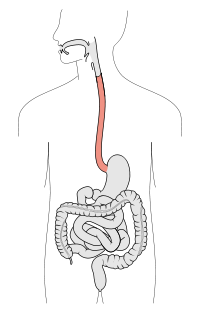
Photo from wikipedia
Introduction The oesophageal body motility in achalasia defines the subtype of the disease. However, it is unknown how the oesophageal body motility changes when challenged with solid swallows as our… Click to show full abstract
Introduction The oesophageal body motility in achalasia defines the subtype of the disease. However, it is unknown how the oesophageal body motility changes when challenged with solid swallows as our clinical practice focuses on water swallows. The aim of this study addresses the topic in question. Method Patients were selected based on Chicago Classification (CC) (version 3)[1] between January to December 2018. High-resolution manometry was performed using the Sierra Scientific Instruments with 36-channel solid-state catheter and Manoscan 3.0.1 was used to capture the recording. Solid bolus swallows were performed using bread with butter sandwich meal and motility assessment (including distal contractile integral [DCI] values) was based on [2]. Fisher exact test was employed to assess for any statistical difference where appropriate. Results Total number of achalasia patients selected was 67 (F:M=45:43, aged 1–7 years) and achalasia subtypes 1, 2 and 3 based on CC were respectively 39.8%, 60.2% and 0%. The solid swallow outcomes for achalasia subtypes 1 and 2 are in table 1.Abstract PWE-094 Table 1 Outcome of achalasia subtypes when challenged with solid bolus Water swallows outcome Type 1 (n=29) Type 2 (n=38) Solid swallows outcome 11 (type 1)15 (type 2)3 (peristalsis observed) 1 (type 1)38 (type 2)2 (peristalsis observed) In 62.1% of patients with primary type 1 achalasia diagnosis on liquid swallow have shown inconsistent features on solid bolus swallow (>20% panoesophageal pressurisation or peristalsis) whereas 86.8% patients with type 2 achalasia diagnosis on primary diagnosis from liquid swallow also showed panoesophageal pressurisation on solid bolus swallows (p=0.0002). There was evidence of peristalsis on solid swallows in type 1 achalasia and type 2 achalasia by 10.2% and 2.63% respectively. Conclusion Type 2 achalasia mostly remains unchanged from liquid swallows to solid swallows. The oesophageal body motility in type 1 achalasia seems to change in >50% when challenged with solid bolus. It is unknown which swallow test method offers the best prognosis for achalasia treatment. Reference Kahrilas PJ, et al. The Chicago Classification of Esophageal Motility Disorders, v3.0Neurogastroenterol Motil 2015;27(2):160–174. Sweis RT, et al. Normal values and inter-observer agreement for liquid and solid bolus swallows in upright and supine positions as assessed by esophageal high-resolution manometry. Neurogastroenterol Motil 2011;23(6):509–516.
Journal Title: Gut
Year Published: 2019
Link to full text (if available)
Share on Social Media: Sign Up to like & get
recommendations!